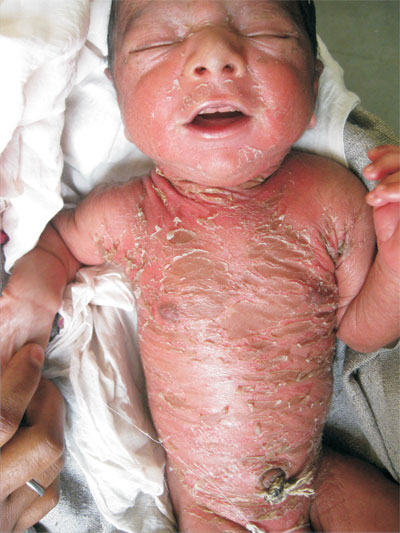A 4-day-old neonate was brought with
complaints of fissuring and peeling of skin involving almost
the whole body. The neonate had generalized desquamation not
even sparing the palms, soles and face. The parents informed
that the baby was born, enclosed in a constricting
parchment-like membrane (collodion baby) that had gradually
come-off. There was a past history of a child born with
similar presentation in the previous pregnancy. There was no
history of consanguinity.
 |
|
Fig. 1 Generalized
fissuring and peeling of skin.
|
On examination, the entire body surface
showed extensive fissuring and peeling of skin (Fig.1).
Diffuse erythema and scaling was also noted, scales being
larger on the legs and finer at other places. No bullae,
vesicles or quadrilateral scales could be found. There was
no ectropion, eclabium or cicatricial alopecia. On
histological examination, parakeratosis and perivascular
neutrophilic infiltration was present. The neonate was
advised symptomatic treatment with topical keratolytics and
emollients.
Non-bullous congenital ichthyosiform
erythroderma belongs to the family of autosomal-recessive
ichthyosis. Lamellar ichthyosis (large, quadrilateral scales
adherent at the centre) and Harlequin fetus are the other
ichthyosiform disorders transmitted in recessive fashion.
Apart from these varieties, ichthyosis may be autosomal
dominant (Ichthyosis vulgaris; characterized by sparing of
the flexures and presence of features suggestive of atopic
dermatitis and keratosis pilaris) or X-linked
ichthyosis (history of prolonged labor, only in males,
presence of cryptorchidism, characteristic pre-auricular
involvement).

